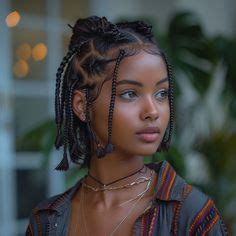The Allure of Braid Hair
Throughout history, braids have transcended cultures and generations as a versatile and captivating form of hair artistry. From intricate cornrows to elegant fishtails, the allure of braid hair lies in its ability to enhance natural beauty and express personal style. With 27 distinct braiding techniques, there’s an endless array of possibilities to explore.

Understanding the Pain Points of Braid Hair
Despite its enduring appeal, braid hair can sometimes come with its own set of challenges:
- Time-consuming: Braiding can be an intricate and laborious process, especially for complex styles.
- Scalp Tension: Tight braiding can cause discomfort and hair breakage, particularly for those with sensitive scalps.
- Limited Styling Options: Once hair is braided, it becomes less versatile for different hairstyles.
Addressing the Motivations Behind Braid Hair
Despite these challenges, the motivations for wearing braid hair are compelling:
- Cultural Expression: Braids hold deep cultural significance in various communities, serving as a symbol of heritage, identity, and tradition.
- Protective Styling: Braiding can protect natural hair from damage caused by heat, chemicals, and environmental factors.
- Fashion Statement: Braids offer a wide range of styles, from edgy to elegant, allowing individuals to express their creativity and individuality.
The Benefits of Braid Hair: Why It Matters
The benefits of braid hair extend beyond aesthetic appeal:
- Reduced Hair Breakage: By keeping hair strands tightly secured, braiding reduces the friction between individual hairs, minimizing breakage.
- Promotes Hair Growth: Braiding helps distribute natural oils evenly throughout the hair, promoting healthy growth.
- Provides Heat Protection: By shielding hair from direct heat sources, braids act as a protective barrier, preventing damage.
- Versatile Styling Options: With 27 diverse braiding techniques available, braid hair provides endless styling possibilities, catering to different face shapes, hair textures, and personal preferences.
Introducing “Braidology”: A New Perspective on Braid Hair
“Braidology” is a creative concept that reframes braid hair as a scientific and artistic discipline. It encompasses the study of braid theory, history, techniques, and applications. By embracing “braidology,” we can unlock the full potential of braid hair and explore its limitless possibilities.
Table 1: Braid Hair for Cultural Expression
| Culture | Significance of Braiding |
|---|---|
| African | Symbol of identity, heritage, and social status |
| Native American | Signifies spiritual beliefs, clan affiliations, and warrior prowess |
| Asian | Represents marriage, fertility, and auspicious occasions |
| Caribbean | Expresses cultural heritage, community, and personal style |
Table 2: Braid Hair for Protective Styling
| Hair Texture | Benefits of Braiding |
|---|---|
| Curly | Prevents tangles, reduces frizz, and protects from breakage |
| Coily | Provides a protective layer against chemical treatments and environmental damage |
| Straight | Minimizes hair loss due to heat styling and mechanical damage |
| Fine | Adds volume and thickness, preventing hair from becoming flat |
Table 3: Braid Hair for Fashion Expression
| Braid Style | Type of Look |
|---|---|
| Cornrows | Edgy and structured |
| Fishtail Braid | Bohemian and elegant |
| French Braid | Sophisticated and romantic |
| Box Braids | Bold and voluminous |
| Micro Braids | Delicate and versatile |
Table 4: Braid Hair for Scalp Health
| Scalp Condition | Benefits of Braiding |
|---|---|
| Sensitive Scalp | Reduces tension and irritation caused by tight hairstyles |
| Psoriasis | Provides a protective barrier, minimizing flare-ups |
| Dandruff | Prevents flakes from forming, allowing scalp treatments to penetrate |
| Alopecia | Helps conceal hair loss and promote healthy scalp circulation |
Embracing the Art of Braid Hair: A Step-by-Step Guide
Step 1: Prepare Your Hair
- Wash and condition hair to remove any dirt or product buildup.
- Use a detangling spray or conditioner to prevent tangles.
- Section hair into smaller sections to make braiding easier.
Step 2: Choose Your Braid Style
- Decide which of the 27 braiding techniques you want to use.
- Consider your hair texture, face shape, and desired look.
Step 3: Create the Braid
- Follow the instructions for your chosen braiding technique.
- Start at the base of your hair and work your way towards the ends.
- Tighten the braid as much or as little as desired.
Step 4: Secure the Braid
- Use a hair elastic or bobby pins to secure the end of the braid.
- If desired, wrap a small section of hair around the elastic to hide it.
Step 5: Style and Finish
- Once all braids are complete, style as desired.
- You can leave braids loose, pin them up, or add accessories.
- Apply a light hairspray to set the style.
The Future of Braid Hair: Innovation and Sustainability
As “braidology” continues to evolve, we can anticipate exciting innovations and sustainable practices in the realm of braid hair.
Innovation:
- 3D Printed Braids: Using advanced 3D printing technology to create intricate and customized braids.
- Virtual Braiding: Developing virtual reality and augmented reality tools that allow users to experiment with different braiding styles without physically altering their hair.
- Biodegradable Braiding Materials: Creating sustainable and biodegradable materials specifically designed for braiding, reducing environmental impact.
Sustainability:
- Hair Reuse Programs: Establishing programs to collect and recycle used braiding materials, preventing waste.
- Ethical Sourcing of Hair: Ensuring that hair used for braiding is ethically sourced and obtained from willing donors.
- Water-Free Braiding Techniques: Developing innovative braiding techniques that do not require water, conserving a precious resource.
Conclusion: The Enduring Legacy of Braid Hair
For centuries, braid hair has been an integral part of human culture and self-expression. With its ability to enhance beauty, protect natural hair, and empower individuals, braid hair continues to captivate and inspire. By embracing the art of “braidology,” we can delve into the intricate world of braids, unlocking their endless possibilities and creating styles that are both timeless and transformative.
